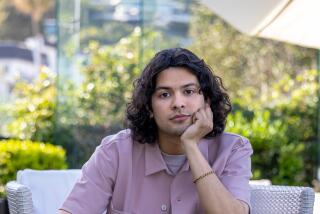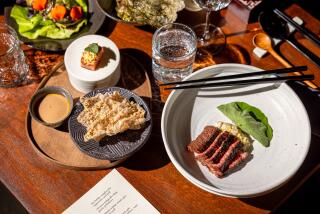‘In the martial arts . . . we teach people to respect themselves and others’
Blossom Valley resident Samuel Alama Kuoha, 43, has three black belts in the martial arts and is grand master of the kara-ho kempo style of karate. A former San Diego policeman and sheriff’s deputy, he is now the leader of a 2,000-student organization and holds a world’s record for breaking 1,500 pounds of ice with a single blow. The father of five, Kuoha was named 1990 Humanitarian of the Year by Inside Kung-Fu magazine. In lieu of exchanging Christmas presents, for the past six years, Kuoha, his wife Dana and youngest daughter Ka’imi have donated nearly $1,000 a year in food and clothing to needy San Diego families. Kuoha was interviewed by Times staff writer G. Jeanette Avent and photographed by Bruce K. Huff.
I was born in Kalihi, a rough neighborhood in Honolulu. In those days, a good percentage of the local boys were involved in the martial arts. They fought all the time. But I didn’t see martial arts as a ticket out of the old neighborhood. It wasn’t even my idea to get into martial arts; it was my mother’s idea. I was the oldest boy and the third oldest out of eight children. My father was full-blooded Hawaiian, and my mother was full-blooded Chinese.
As a kid, I was smaller than most kids my age. I was really skinny and I had a discipline problem. She could see I had a hot temper like my dad, and she was very concerned about it. She got me started training in martial arts at a really young age because of the people in the martial arts. The black belts were real discipline-oriented, unlike some instructors who would just teach the physical aspects of martial arts. They wanted me to learn the mental attitude behind it.
I learned martial arts in a little house that was remodeled as a Buddhist shrine. I started training when I was 5 and I went into the temple when I was 12. I lived there for 6 1/2 years. I trained 8 to 10 hours a day, 5 1/2 days a week, plus I went to school. I averaged about four hours of sleep a night even as a kid. I was released from the temple when I was 18.
I think martial arts was the thing for me. But for me to say that was my ticket out of Hawaii, I don’t think so. At 5 years old, how do you say this is your ticket, something you’re going to be doing for the rest of your life? After leaving the temple, I just got tired of being in Hawaii and not being able to get ahead and do something I really wanted to progress in.
Kara-ho kempo was developed in Hawaii by professor William Kwai-sun Chow, who learned from his father, who was a Buddhist priest from Shanghai. Professor Chow transformed it into a street-fighting style in Hawaii. He was into full-on fighting in the classroom rather than sparring. I used to get broken ribs. It was bad. That’s how we learned it. But in the middle ‘70s, I kept telling him this is not the way. I planted a seed in his mind and I just kept talking to him. That part has changed.
A lot of people write about me in magazines and it really bothers me that they’re saying I’m the deadliest man alive. I don’t want to be portrayed as a violent person. I try every single day of my life to do things that are good not only for myself but my family, and to show respect for others. In the martial arts, the way we teach it, we teach people to respect themselves and others, and discipline their mind so they will have control over the entire body rather than the body controlling the mind. Then it becomes a way of life, something you do every single day of your life.
If you have to hurt people to get where you want, then find yourself another choice because that’s not the choice to make. I’ve turned down films because I knew it would hurt somebody else by doing it. I’ll kill anyone on film because it’s fake, but I won’t do any nude scenes or any alcohol or tobacco commercials. I’ve already turned down two alcohol commercials, including one worth $70,000. I wouldn’t want people to do something I wouldn’t do myself, especially when I have a son going on a church mission. It may have slowed my career down a little bit, but I don’t think so.
I’ve been doing films seven years now, and I’m producing and writing. I’ve acted or worked as a stunt man in the “Return of the Killer Tomatoes” and “K-9,” with Jim Belushi. I’ve signed a six-picture deal, the first a $2-million picture with Columbia which they hope to shoot in Rio de Janeiro with Bruce Willis. I’ll be acting in it. I’ve also made a bid to be stunt action coordinator of the third “Return of the Killer Tomatoes,” to be shot in San Diego. I want to be big in the film business, but not just for the usual reasons. The most important reason I decided I wanted to go into films is the youth of today are looking up to people in the entertainment business. That’s what I want. I go to schools and I talk to students about the abuse of alcohol and drugs, setting goals for their lives, how to obtain these goals, and how to be in any type of business and keep your morals. This is what I enjoy doing. I feel if one person listens to me, that time I’ve given is well worth it.
More to Read
Sign up for Essential California
The most important California stories and recommendations in your inbox every morning.
You may occasionally receive promotional content from the Los Angeles Times.









